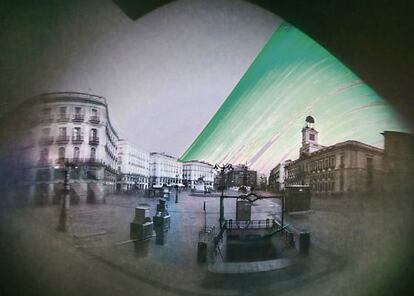Sunshine in a can
The art of ‘solargraphy’ beams into Madrid


The only object that leaves a trace is the sun. There are no people in the squares, nobody smoking on the balconies. No birds flying across the sky.
This is the kind of image you get when you hide a drinks can with a tiny hole and a slip of photosensitive paper inside in a strategic corner for six months. And if you do so in 15 countries at different latitudes, from Germany to Uganda, what you get is an in-depth study of the behavior of the sun in different corners of the globe.
The technique is known as solargraphy and it attempts to show the path of the sun during the winter and summer solstices. Time in a Can, now on at the Fundación Diario Madrid, is the first international exhibition devoted to the practice. “They are images that are questions,” says Diego López Calvín, the creator of solargraphy and promoter of the event.
The show features the work of 40 artists, who were selected for their experience and their strategic location. The pinhole cameras are “self-built” with drinks cans of a specific size. The light passes through the tiny hole in the can and the image materializes on the photosensitive paper inside. “We use cans because as they are placed on balconies, rocks or in trees they have to resist the weather conditions of each place, whether it is Ecuador or the North Pole,” López explains.
From film set to web
The photograph is formed by the darkening of the paper and does not need developing. Once the exposure time is complete, the image is taken to Estudios Redondo in Madrid where it is scanned and digitally adjusted. Not all the cans end up getting collected. “Some are taken by tourists,” he says.
“If it has been cloudy, you can see a gap in the trace left by the path of light of the sun,” López explains. The exposure time is so slow that any movement made in front of the camera disappears from the final image. “In areas where cars are always parked, for instance, you can see the outline of a vehicle that you might consider the generic outline of all of them.”
López came up with the idea of solargraphy 13 years ago when he was working on the set of the film Sex and Lucia. After that he traveled to Poland to visit two friends, Slawomir Decyk and Pawel Kula, who both work with pinhole cameras. With them he came up with the idea for the Solaris project, which now shares its solargraphy works on the internet. His website, at www.solarigrafia.com, now features contributions from more than 100 countries.
Time in a can. Until July 31 at Fundación Diario Madrid, C/ Larra 14, Madrid. www.timeinacan.org
Tu suscripción se está usando en otro dispositivo
¿Quieres añadir otro usuario a tu suscripción?
Si continúas leyendo en este dispositivo, no se podrá leer en el otro.
FlechaTu suscripción se está usando en otro dispositivo y solo puedes acceder a EL PAÍS desde un dispositivo a la vez.
Si quieres compartir tu cuenta, cambia tu suscripción a la modalidad Premium, así podrás añadir otro usuario. Cada uno accederá con su propia cuenta de email, lo que os permitirá personalizar vuestra experiencia en EL PAÍS.
¿Tienes una suscripción de empresa? Accede aquí para contratar más cuentas.
En el caso de no saber quién está usando tu cuenta, te recomendamos cambiar tu contraseña aquí.
Si decides continuar compartiendo tu cuenta, este mensaje se mostrará en tu dispositivo y en el de la otra persona que está usando tu cuenta de forma indefinida, afectando a tu experiencia de lectura. Puedes consultar aquí los términos y condiciones de la suscripción digital.
Últimas noticias
The complicated life of Francesca Albanese: A rising figure in Italy but barred from every bank by Trump’s sanctions
Half of Scotland is in the hands of 420 property owners
Pinochet’s victims grapple with José Antonio Kast’s rise in Chile
Reinhard Genzel, Nobel laureate in physics: ‘One-minute videos will never give you the truth’
Most viewed
- Pablo Escobar’s hippos: A serious environmental problem, 40 years on
- Why we lost the habit of sleeping in two segments and how that changed our sense of time
- Charles Dubouloz, mountaineering star, retires at 36 with a farewell tour inspired by Walter Bonatti
- Reinhard Genzel, Nobel laureate in physics: ‘One-minute videos will never give you the truth’
- The Florida Keys tourist paradise is besieged by immigration agents: ‘We’ve never seen anything like this’








































